Experimental Study of Radiated Emission Due to Secondary Common-Mode Current in Buck Converters
Abstract
:1. Introduction
2. Configuration of Experimental System
3. Generation Mechanism of the SCM Noise in the Experimental System
4. Noise Measurements in the Experimental System
4.1. Common-Mode Currents
4.2. Radiated Emission
5. Conclusions
Funding
Institutional Review Board Statement
Informed Consent Statement
Data Availability Statement
Acknowledgments
Conflicts of Interest
Nomenclature
| IDM | Differential-mode current |
| IPCM | Primary common-mode current |
| ISCM | Secondary common-mode current |
| VE | Voltage potential of the terminal E for the ground |
| VN | Voltage potential of the terminal N for the ground |
| VP | Voltage potential of the terminal P for the ground |
| VPCM | Primary common-mode voltage |
| VSCM | Secondary common-mode voltage |
| ZDM | Differential-mode impedance |
| ZE | Impedance of the ground wire E |
| ZG | Impedance between the terminal E and the ground plane |
| ZLISN | Impedance of the line impedance stabilization network |
| ZN | Impedance of the power line N |
| ZP | Impedance of power the line P |
| ZPCM | Primary common-mode impedance |
| ZSCM | Secondary common-mode impedance |
References
- Sengupta, S.; Kumar, A.; Tiwari, S. Transient stability enhancement of a hybrid Wind-PV farm incorporating a STATCOM. In Proceedings of the 2018 3rd IEEE International Conference on Recent Trends in Electronics, Information & Communication Technology (RTEICT), Bangalore, India, 18–19 May 2018; pp. 1574–1580. [Google Scholar]
- Sinha, S.; Chandel, S.S.; Malik, P. Investigation of a building-integrated solar photovoltaic-wind-battery hybrid energy system: A case study. Int. J. Energy Res. 2021, 45, 21534–21539. [Google Scholar] [CrossRef]
- Biela, J.; Schweizer, M.; Waffler, S.; Kolar, J.W. SiC versus Si—Evaluation of Potentials for Performance Improvement of Inverter and DC–DC Converter Systems by SiC Power Semiconductors. IEEE Trans. Ind. Electron. 2011, 58, 2872–2882. [Google Scholar] [CrossRef]
- Han, D.; Li, S.; Wu, Y.; Sarlioglu, B. Comparative Analysis on Conducted CM EMI Emission of Motor Drives: WBG Versus Si Devices. IEEE Trans. Ind. Electron. 2017, 64, 8353–8363. [Google Scholar] [CrossRef]
- Engelmann, D.G.; Sewergin, A.; Neubert, M.; De Doncker, R.W. Design Challenges of SiC Devices for Low- and Medium-Voltage DC-DC Converters. IEEJ J. Ind. Appl. 2019, 8, 505–511. [Google Scholar] [CrossRef]
- Zhang, B.; Wang, S. A Survey of EMI Reserch in Power Electronics Systems with Wide-Bandgap Semiconductor Devices. IEEE J. Emerg. Sel. Topics Powe Electron. 2020, 8, 626–643. [Google Scholar] [CrossRef]
- Takahashi, S.; Wada, K.; Ayano, H.; Ogasawara, S.; Shimizu, T. Review of Modeling and Suppression Techniques for Electromagnetic Interference in Power Conversion Systems. IEEJ J. Ind. Appl. 2022, 11, 7–19. [Google Scholar] [CrossRef]
- Ogasawara, S.; Akagi, H. Modeling and Damping of High-Frequency Leakage Currents in PWM Inverter-Fed AC Motor Drive Systems. IEEE Trans. Ind. Appl. 1996, 32, 1105–1114. [Google Scholar] [CrossRef]
- Akagi, H.; Hasegawa, H.; Doumoto, T. Design and Performance of a Passive EMI Filter for Use with a Voltage-Source PWM Inverter Having Sinusoidal Output Voltage and Zero Common-Mode Voltage. IEEE Trans. Power Electron. 2004, 19, 1069–1076. [Google Scholar] [CrossRef]
- Ogasawara, S.; Ayano, H.; Akagi, H. An Active Circuit for Cancellation of Common-Mode Voltage Generated by a PWM Inverter. IEEE Trans. Power Electron. 1998, 13, 835–841. [Google Scholar] [CrossRef]
- Takahashi, S.; Maekawa, S. Attenuation Characteristics of the Input/Output Coupling Passive EMI Filter on Conducted Emission in Motor Drive Systems. IEEJ J. Ind. Appl. 2022, 11, 709–710. [Google Scholar] [CrossRef]
- Wang, A.; Zhang, F.; Gao, T.; Wu, Z.; Li, X. Integrated CM Inductor for Both DC and AC Noise Attenuation in DC-Fed Motor Drive Systems. IEEE Trans. Power Electron. 2023, 38, 510–522. [Google Scholar] [CrossRef]
- Julian, A.L.; Oriti, G.; Lipo, T.A. Elimination of Common-Mode Voltage in Three-Phase Sinusoidal Power Converters. IEEE Trans. Power Electron. 1999, 14, 982–989. [Google Scholar] [CrossRef]
- Han, D.; Morris, C.T.; Sarlioglu, B. Common-Mode Voltage Cancellation in PWM Motor Drives With Balanced Inverter Topology. IEEE Trans. Ind. Electron. 2017, 64, 2683–2688. [Google Scholar] [CrossRef]
- Han, D.; Lee, W.; Li, S.; Sarlioglu, B. New Method for Common Mode Voltage Cancellation in Motor Drives: Concept, Realization, and Asymmetry Influence. IEEE Trans. Power Electron. 2018, 33, 1188–1201. [Google Scholar] [CrossRef]
- Xie, L.; Yuan, X. Common-Mode Current Reduction at DC and AC Sides in Inverter Systems by Passive Cancellation. IEEE Trans. Power Electron. 2021, 36, 9069–9079. [Google Scholar] [CrossRef]
- Xie, L.; Yuan, X.; Zhu, H.; Lo, Y.-K. Common-Mode Voltage Cancellation for Reducing the Common-Mode Noise in DC–DC Converters. IEEE Trans. Ind. Electron. 2021, 68, 3887–3897. [Google Scholar] [CrossRef]
- Xie, L.; Yuan, X. Non-Isolated DC-DC Converters With Low Common-Mode Noise by Using Split-Winding Configuration. IEEE Trans. Power Electron. 2022, 37, 452–461. [Google Scholar] [CrossRef]
- Hockanson, D.M.; Drewniak, J.L.; Hubing, T.H.; Van Doren, T.P.; Fei, S.; Wilhelm, M.J. Investigation of Fundamental EMI Source Mechanisms Driving Common-Mode Radiation from Printed Circuit Boards with Attached Cables. IEEE Trans. Electromagn. Compat. 1996, 38, 557–566. [Google Scholar] [CrossRef]
- Roc’h, A.; Leferink, F. Nanocrystalline Core Material for High-Performance Common Mode Inductors. IEEE Trans. Electromagn. Compat. 2012, 54, 785–791. [Google Scholar] [CrossRef]
- Laour, M.; Tahmi, R.; Vollaire, C. Modeling and Analysis of Conducted and Radiated Emissions due to Common Mode Current of a Buck Converter. IEEE Trans. Electromagn. Compat. 2017, 59, 1260–1267. [Google Scholar] [CrossRef]
- Takahashi, S.; Ogasawara, S.; Orikawa, K.; Takemoto, M.; Tamate, M. An Active Common-Mode Filter for Reducing Radiated Noise from Power Cables. In Proceedings of the 2017 IEEE 3rd International Future Energy Electronics Conference and ECCE Asia (IFEEC 2017—ECCE Asia), Kaohsiung, Taiwan, 3–7 June 2017; pp. 1753–1758. [Google Scholar]
- Yao, J.; Li, Y.; Zhao, H.; Wang, S.; Wang, Q.; Lu, Y.; Fu, D. Modeling and Reduction of Radiated Common Mode Current in Flyback Converters. In Proceedings of the 2018 IEEE Energy Conversion Congress and Exposition (ECCE), Portland, OR, USA, 23–27 September 2018; pp. 6613–6620. [Google Scholar]
- Zhang, Y.; Wang, S.; Chu, Y. Investigation of Radiated Electromagnetic Interference for an Isolated High-Frequency DC–DC Power Converter With Power Cables. IEEE Trans. Power Electron. 2019, 34, 9632–9643. [Google Scholar] [CrossRef]
- Yao, J.; Wang, S.; Luo, Z. Modeling, Analysis, and Reduction of Radiated EMI Due to the Voltage Across Input and Output Cables in an Automotive Non-Isolated Power Converter. IEEE Trans. Power Electron. 2022, 37, 5455–5465. [Google Scholar] [CrossRef]
- Ma, Z.; Wang, S.; Sheng, H.; Lakshmikanthan, S. Modeling, Analysis and Mitigation of Radiated EMI Due to PCB Ground Impedance in a 65 W High-Density Active-Clamp Flyback Converter. IEEE Trans. Ind. Electron. 2023, 70, 12267–12277. [Google Scholar] [CrossRef]
- Nobunaga, T.; Toyota, Y.; Iokibe, K.; Koga, L.R.; Watanabe, T. Evaluation of Pigtail Termination of STP Cable Using Model Equivalent Circuit of Four-Conductor Transmission Systems. In Proceedings of the 2013 International Symposium on Electromagnetic Theory, Hiroshima, Japan, 23–24 May 2013; pp. 222–225. [Google Scholar]
- Vincent, M.; Klingler, M.; Riah, Z.; Azzouz, Y. Influence of Car Body Materials on the Common-Mode Current and Radiated Emissions Induced by Automotive Shielded Cables. In Proceedings of the 2015 IEEE International Symposium on Electromagnetic Compatibility (EMC), Dresden, Germany, 16–22 August 2015; pp. 726–731. [Google Scholar]
- Zhang, N.; Kim, J.; Nah, W. Novel Extended Mixed-Mode S-Parameters and Mode Conversion of Four-Conductor Lines. In Proceedings of the 2015 Asia-Pacific Symposium on Electromagnetic Compatibility (APEMC), Taipei, Taiwan, 25–29 May 2015; pp. 712–715. [Google Scholar]
- Instruction Manual for Line Impedance Stabilization Network Model LI-325C 10 kHz to 400 MHz. Available online: https://documentation.com-power.com/pdf/LI-325C-2.pdf (accessed on 22 October 2023).
- Foissac, M.; Schanen, J.; Vollaire, C. “Black Box” EMC Model for Power Electronics Converter. In Proceedings of the 2009 IEEE Energy Conversion Congress and Exposion, San Jose, CA, USA, 20–24 September 2009; pp. 3609–3615. [Google Scholar]
- Bishnoi, H.; Baisden, A.C.; Mattavelli, P.; Boroyevich, D. Analysis of EMI Terminal Modeling of Switched Power Converters. IEEE Trans. Power Electron. 2012, 27, 3924–3933. [Google Scholar] [CrossRef]
- Amara, M.; Vollaire, C.; Ali, M.; Costa, F. Black Box EMC Modeling of a Three Phase Inverter. In Proceedings of the 2018 International Symposium on Electromagnetic Compatibility (EMC EUROPE), Amsterdam, The Netherlands, 27–30 August 2018; pp. 642–647. [Google Scholar]
- Yao, J.; Li, Y.; Zhao, H.; Wang, S. Design of CM Inductor Based on Core Loss for Radiated EMI Reduction in Power Converters. In Proceedings of the 2019 IEEE Applied Power Electronics Conference and Exposition (APEC), Long Beach, CA, USA, 25–29 February 2019; pp. 2673–2680. [Google Scholar]

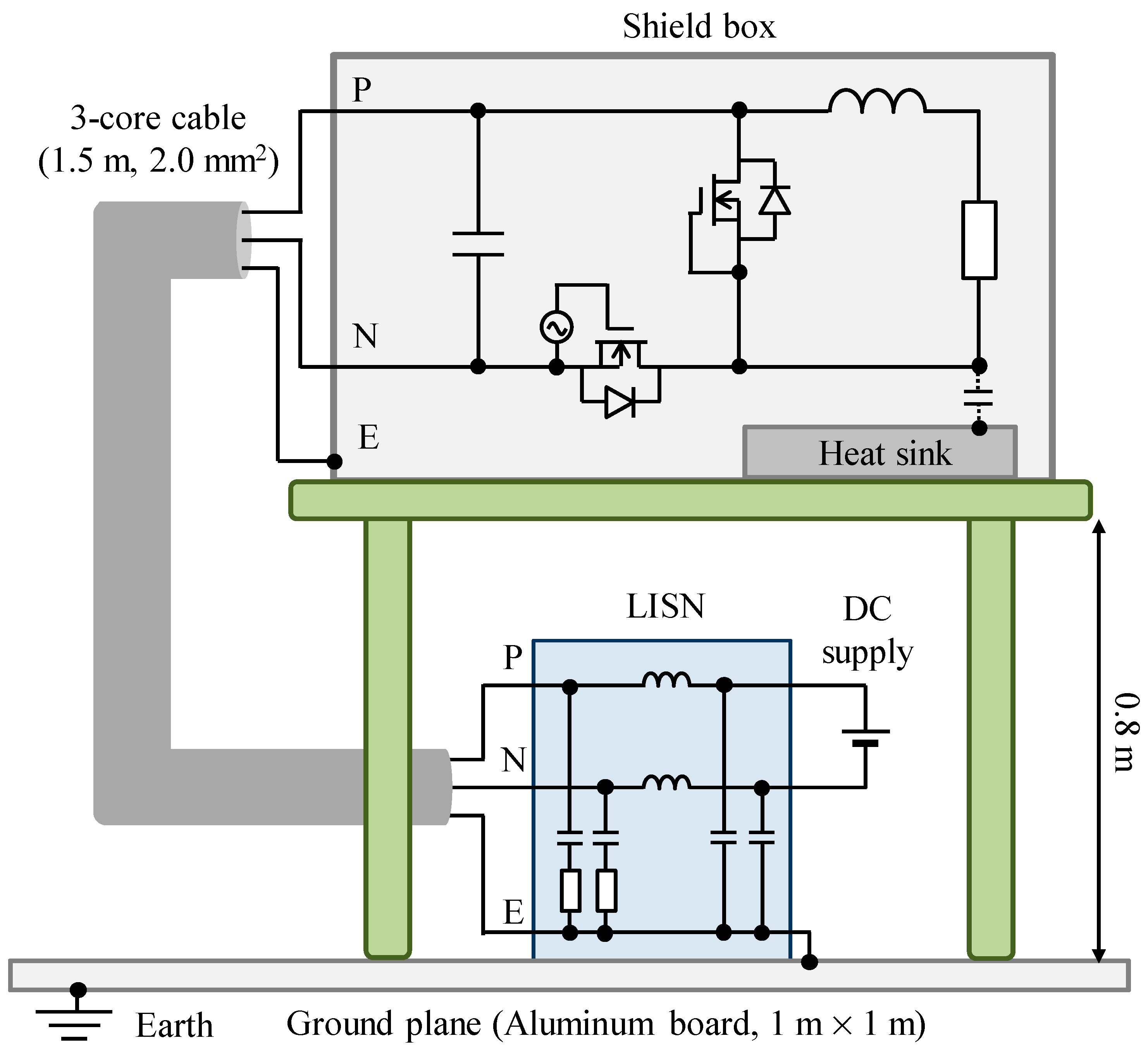

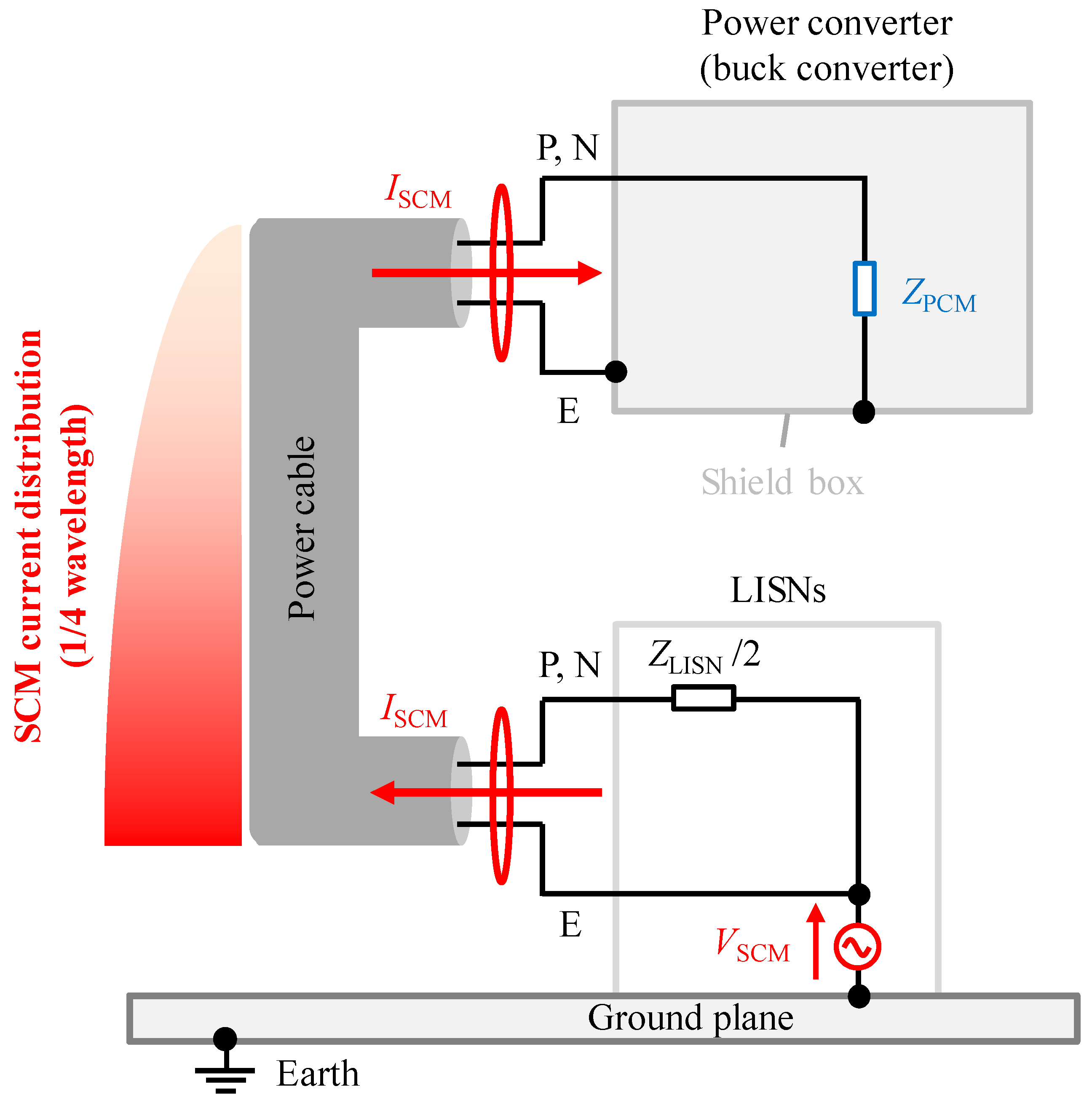
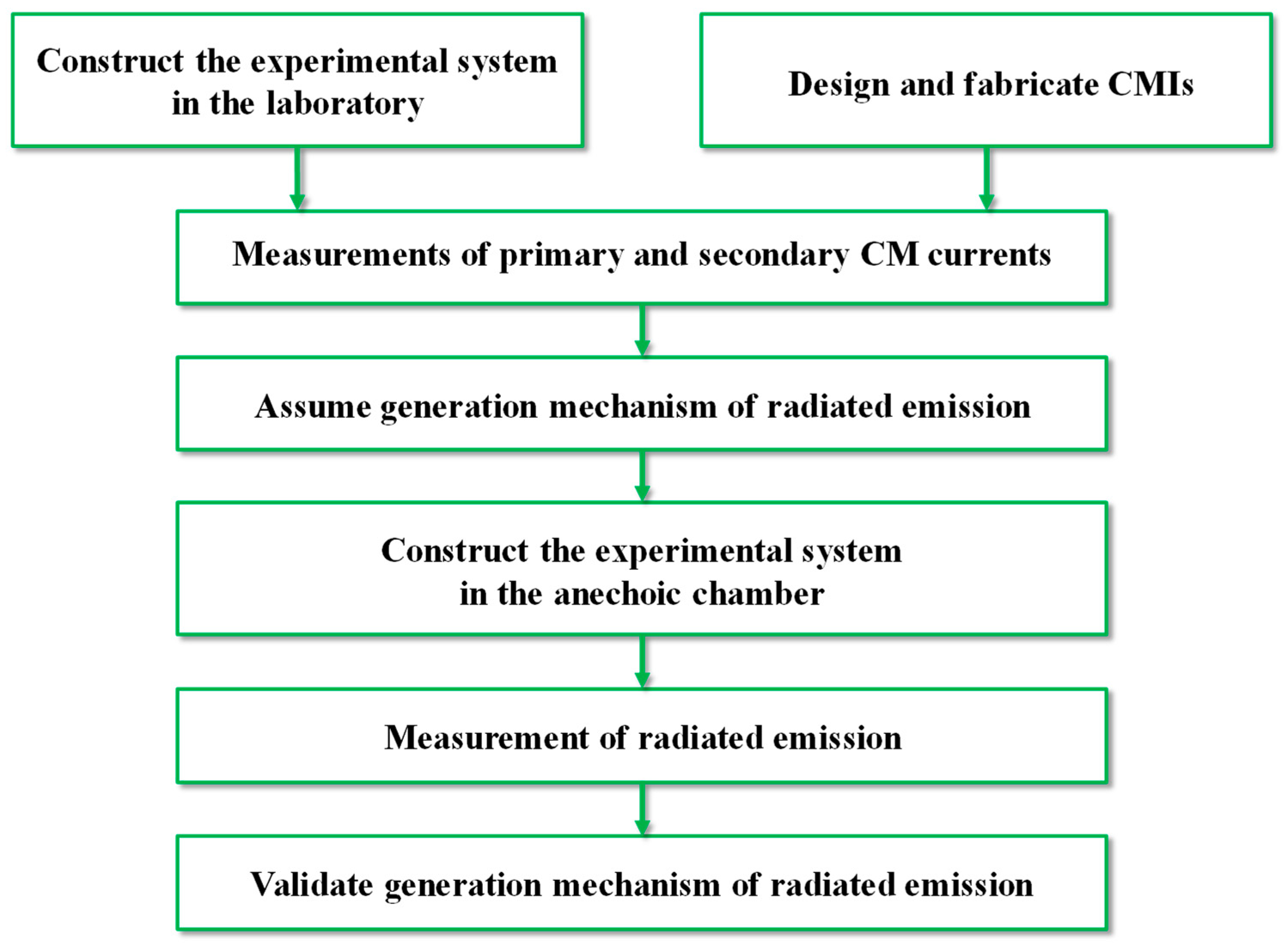
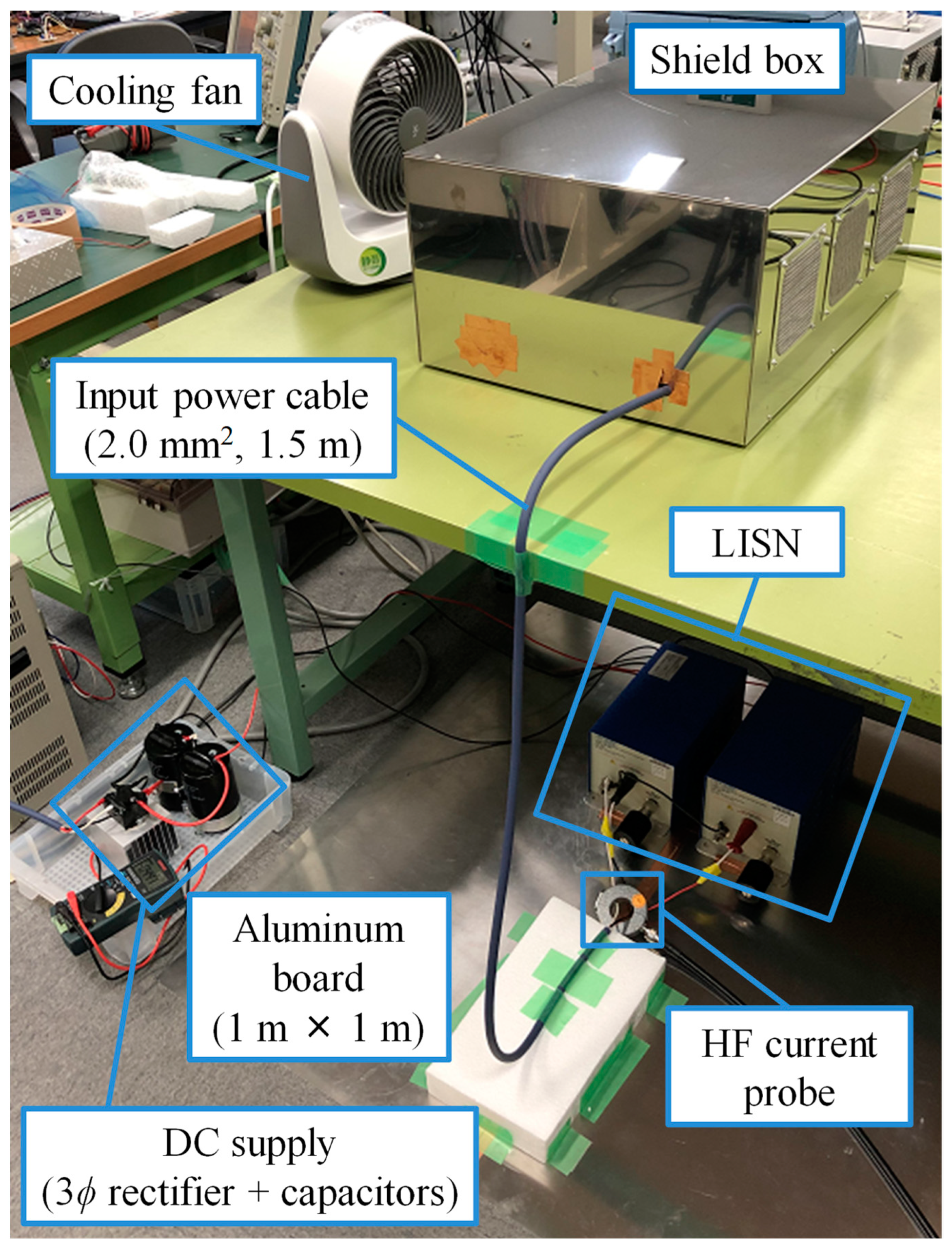


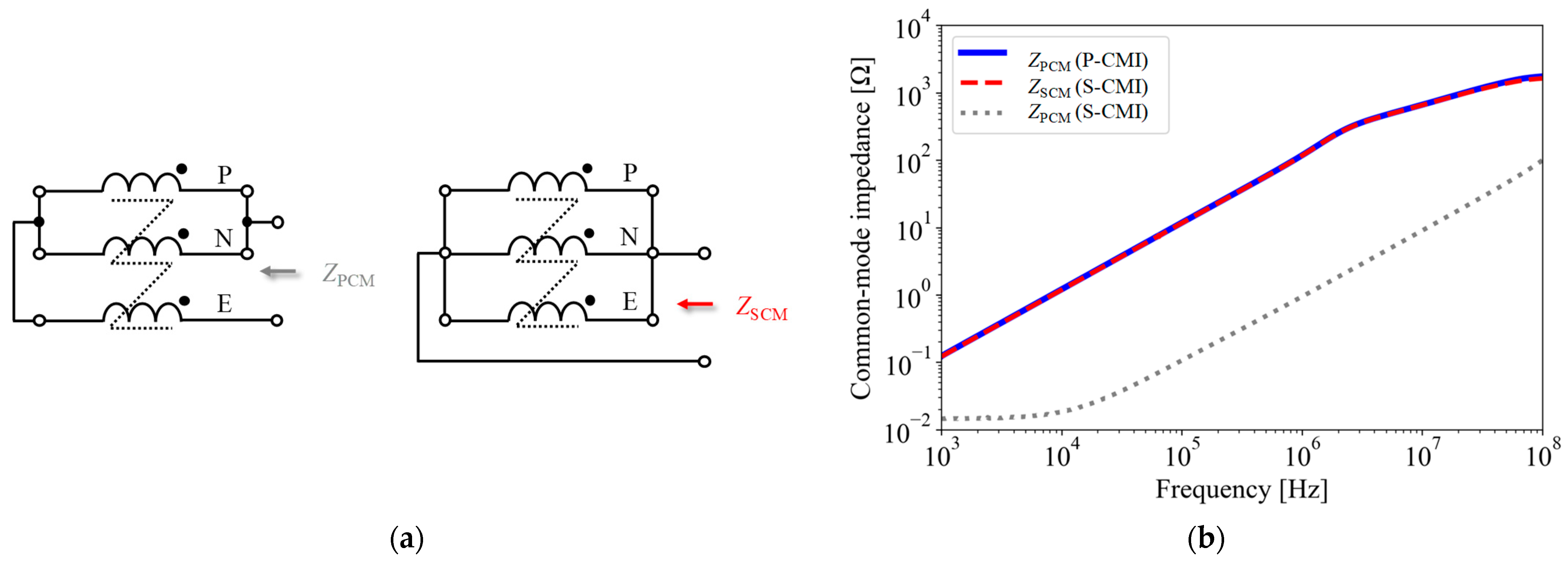
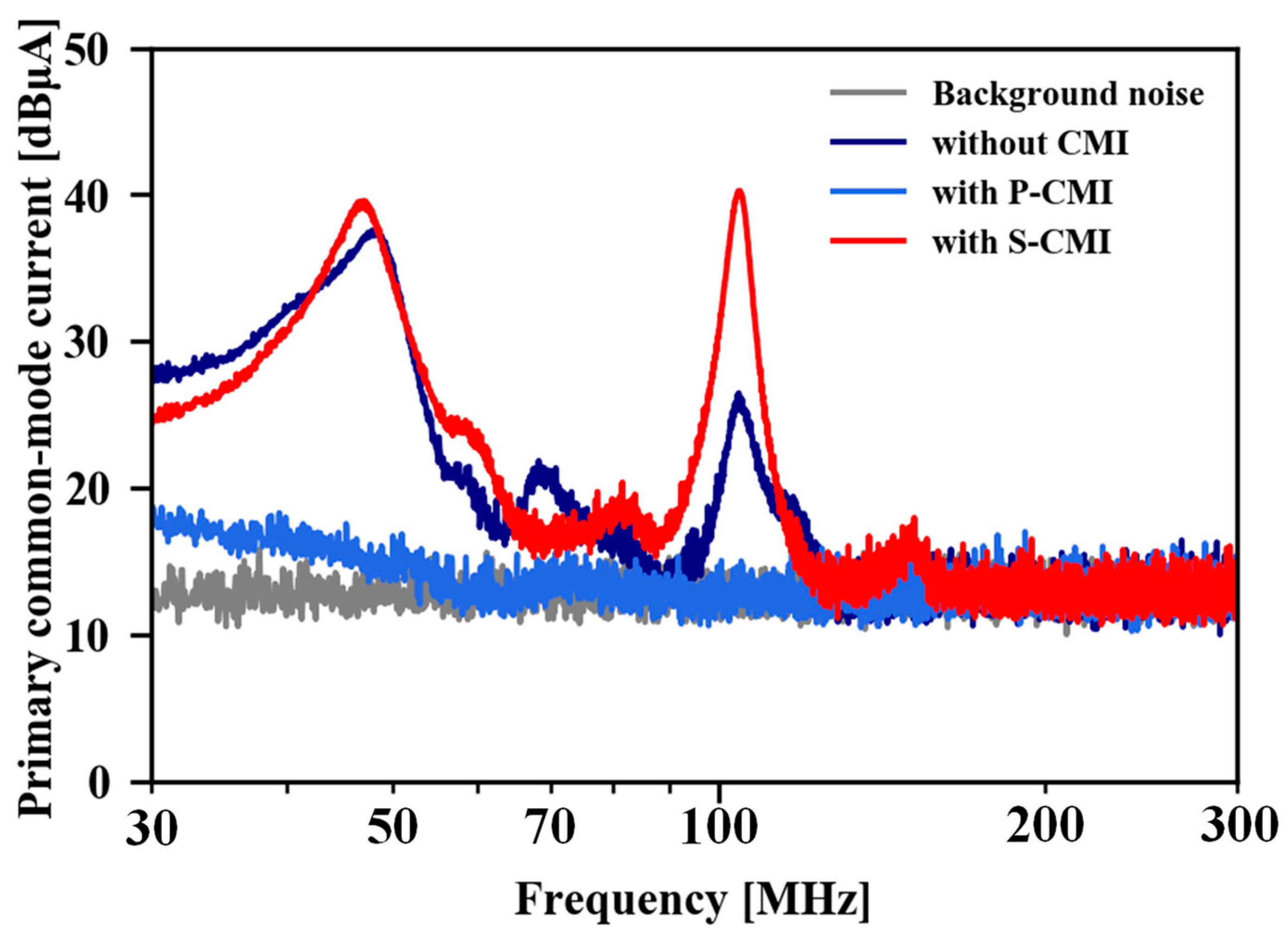
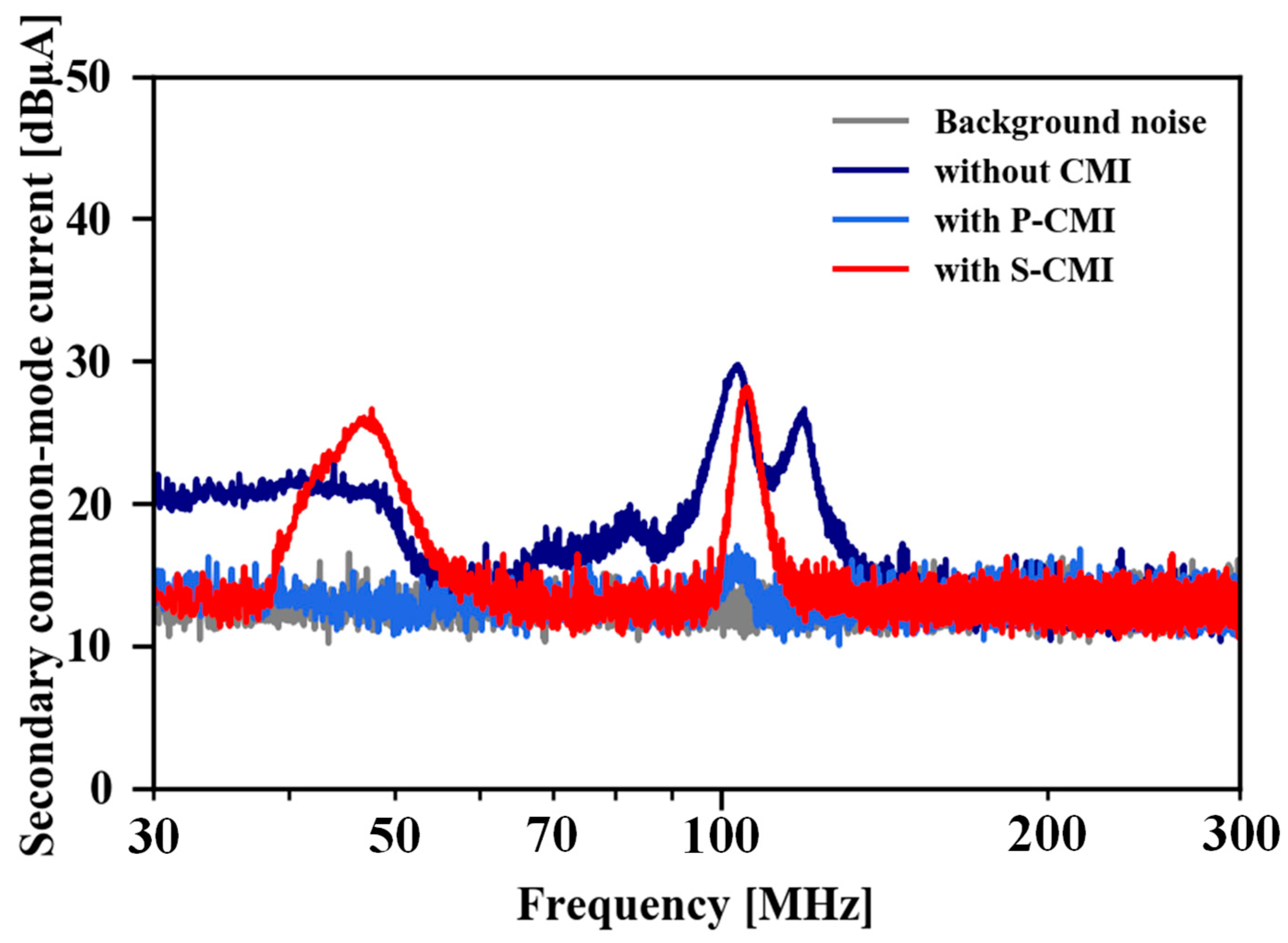

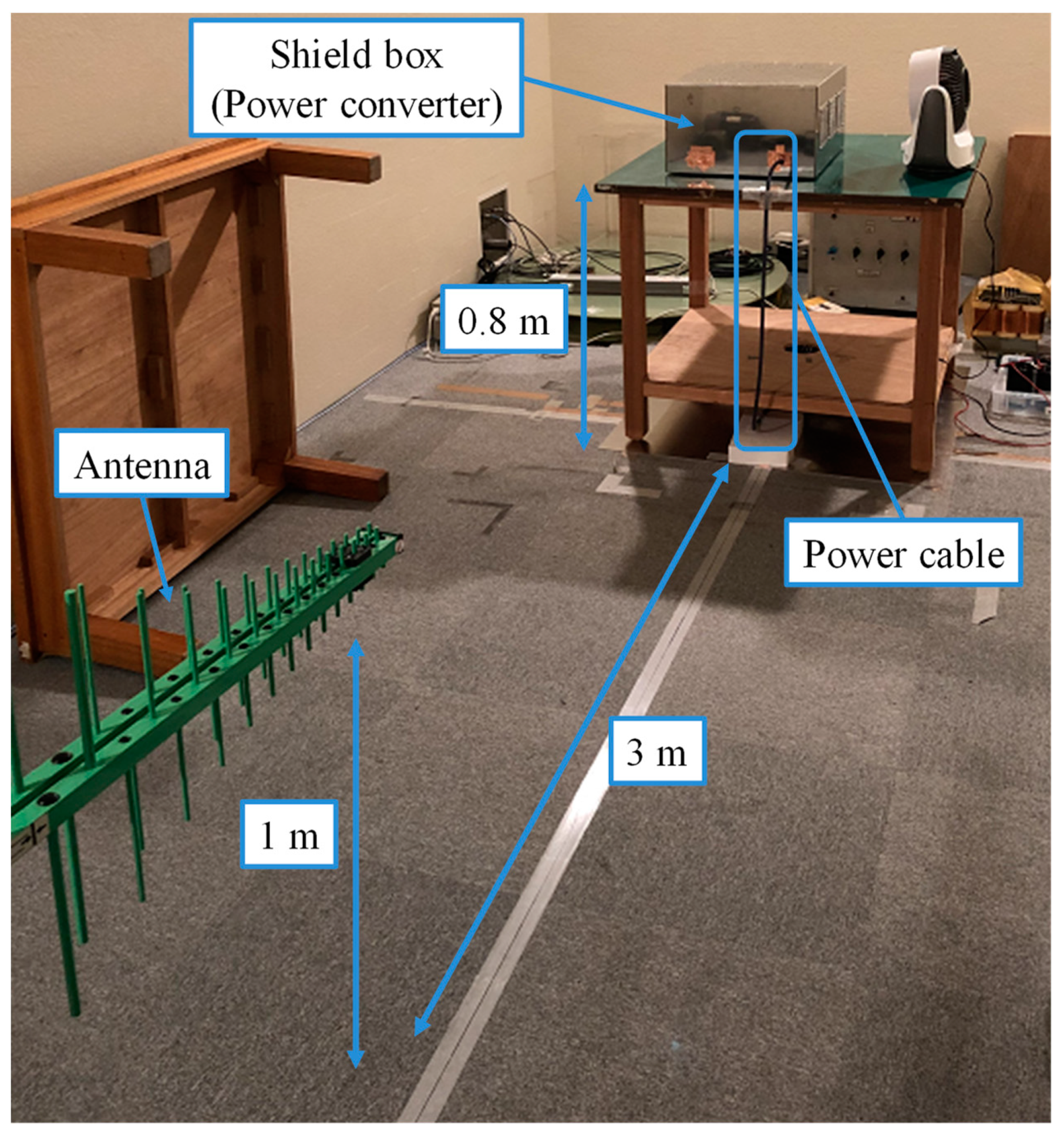
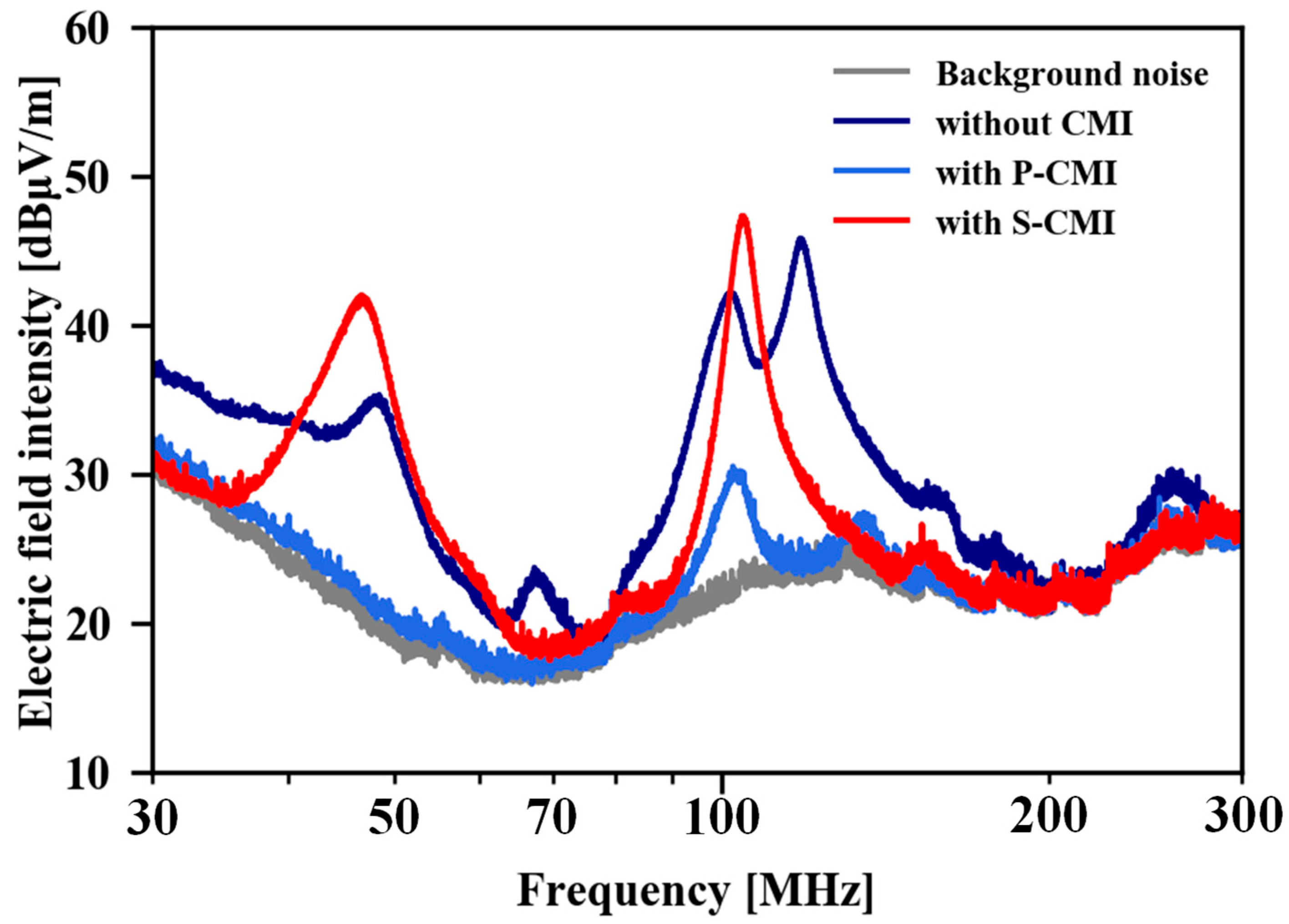
Disclaimer/Publisher’s Note: The statements, opinions and data contained in all publications are solely those of the individual author(s) and contributor(s) and not of MDPI and/or the editor(s). MDPI and/or the editor(s) disclaim responsibility for any injury to people or property resulting from any ideas, methods, instructions or products referred to in the content. |
© 2023 by the author. Licensee MDPI, Basel, Switzerland. This article is an open access article distributed under the terms and conditions of the Creative Commons Attribution (CC BY) license (https://creativecommons.org/licenses/by/4.0/).
Share and Cite
Takahashi, S. Experimental Study of Radiated Emission Due to Secondary Common-Mode Current in Buck Converters. Appl. Sci. 2023, 13, 11735. https://doi.org/10.3390/app132111735
Takahashi S. Experimental Study of Radiated Emission Due to Secondary Common-Mode Current in Buck Converters. Applied Sciences. 2023; 13(21):11735. https://doi.org/10.3390/app132111735
Chicago/Turabian StyleTakahashi, Shotaro. 2023. "Experimental Study of Radiated Emission Due to Secondary Common-Mode Current in Buck Converters" Applied Sciences 13, no. 21: 11735. https://doi.org/10.3390/app132111735





